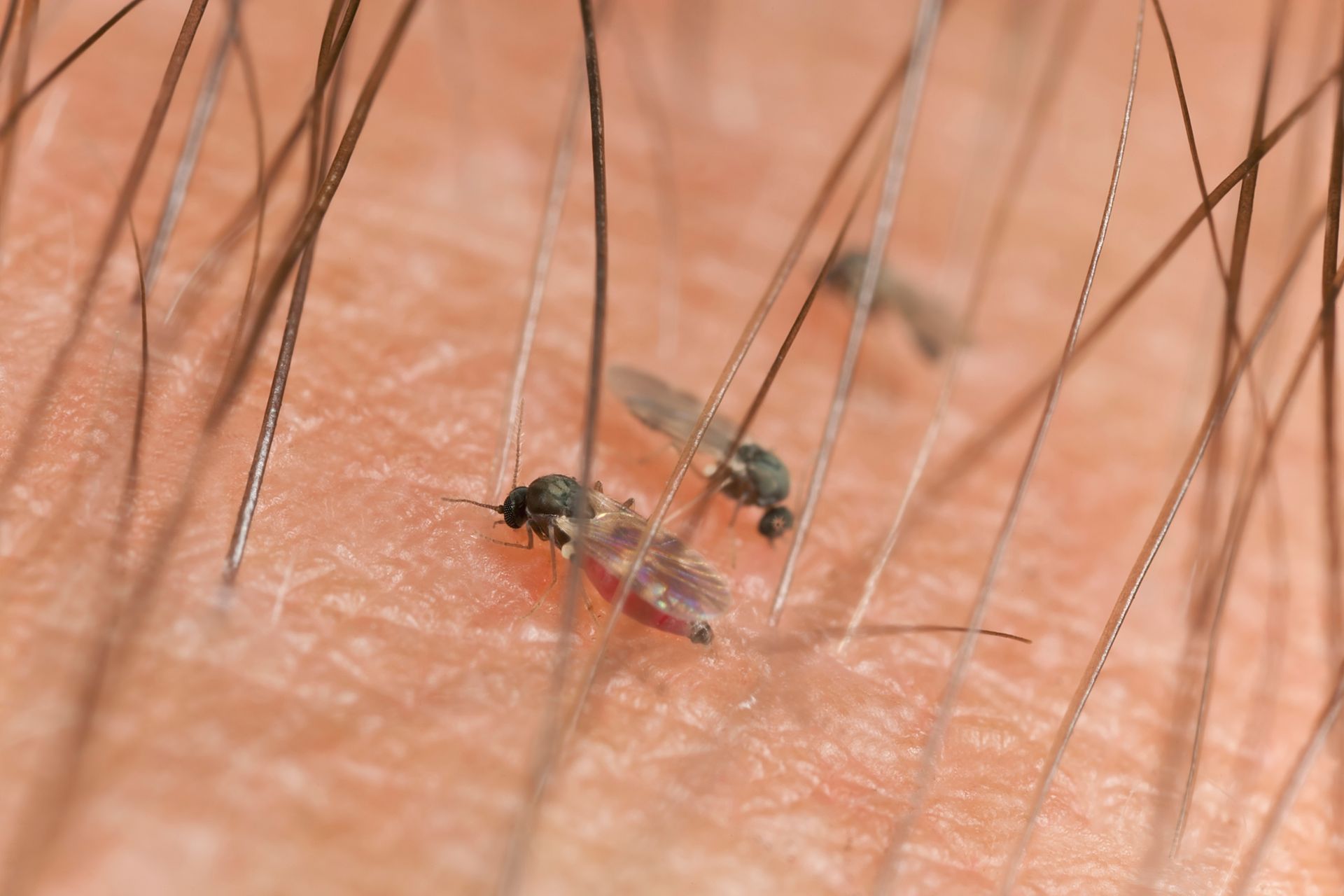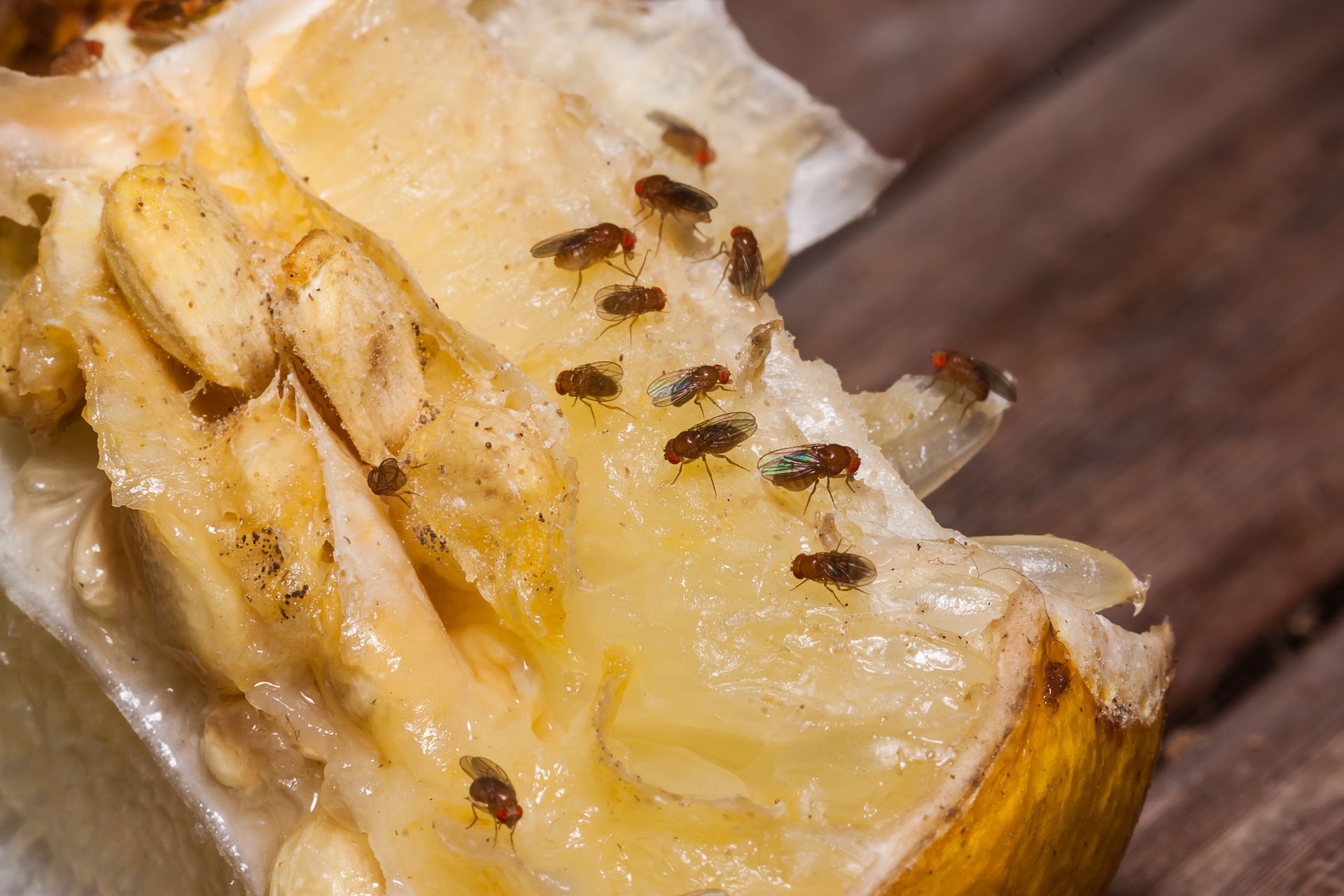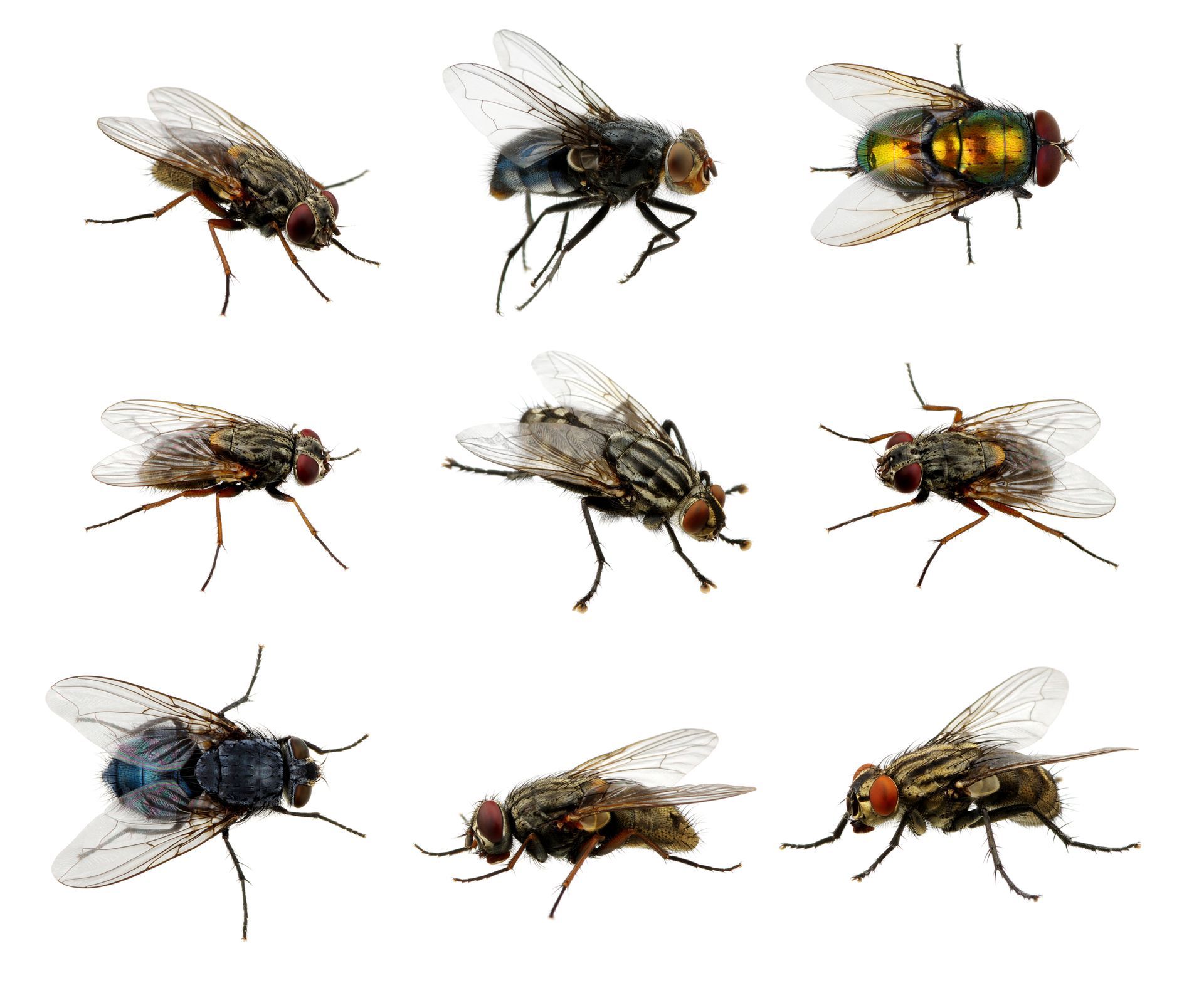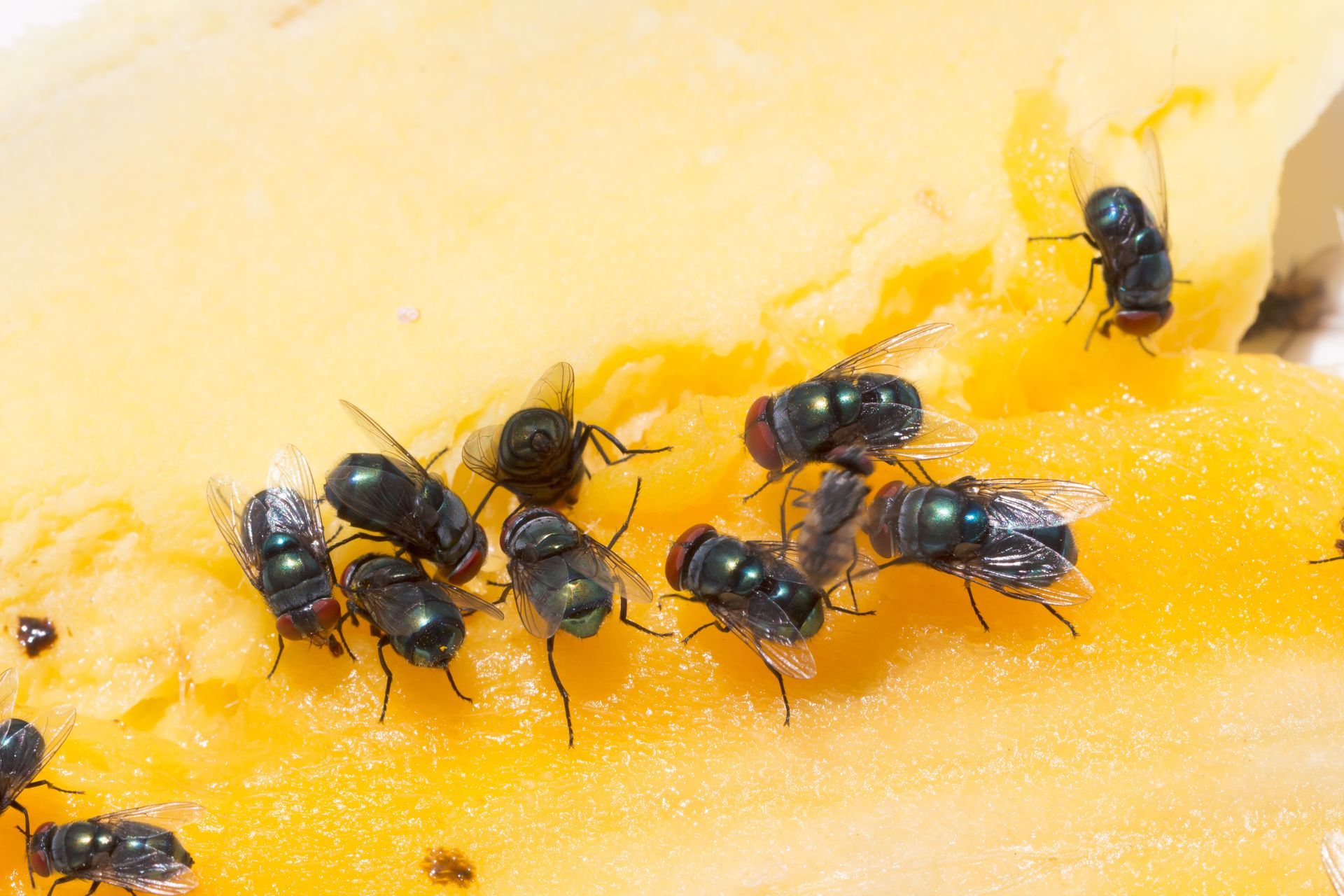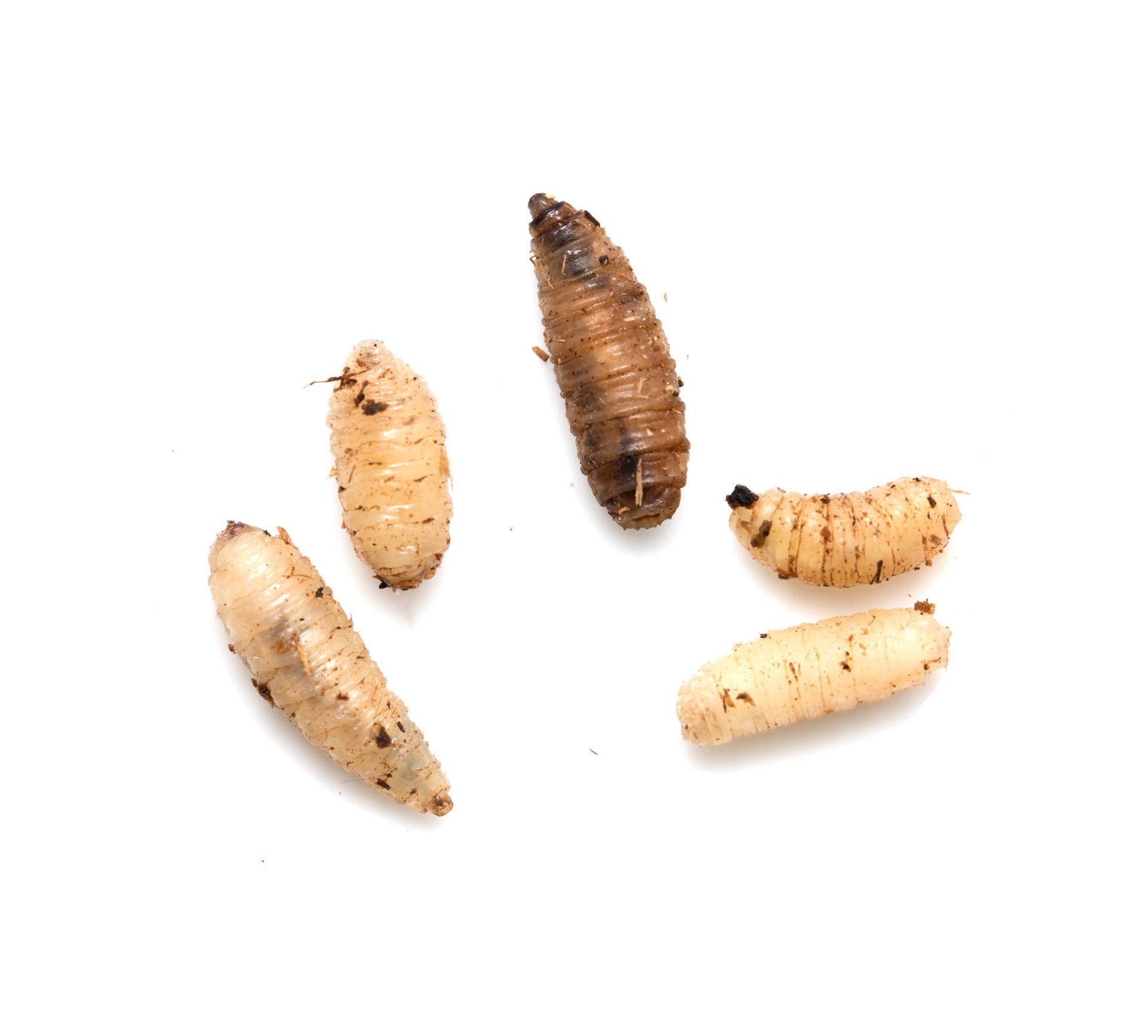Fly Pest Control
The persistent buzzing, constant landing on food surfaces, and unsightly specks on windows and light fixtures signal more than a minor annoyance. These signs indicate a developing fly infestation that requires professional intervention. These winged invaders constantly shuttle between filth and food, transporting dangerous pathogens while reproducing at astonishing rates in hidden breeding sites throughout your property. EcoGuard Pest Management delivers fly elimination strategies that not only eradicate current populations but also create protective barriers against these disease carrying pests, restoring sanitation and comfort to your environment.
Call today for a free estimate. 866-328-2847
Pest FREE Guarantee
All Natural Services
Licensed & Insured
Competitive Pricing
Professional Fly Control Experts
Effective fly control demands specialized knowledge of these diverse pests' biology, breeding preferences, and behavioral patterns. Our highly trained fly control technicians understand the distinct characteristics of different fly species enable precise identification of infestation sources that untrained observers typically miss. This expertise allows us to implement targeted treatment protocols that eliminate adult populations while addressing breeding sites and entry points to prevent future problems.
Why Flies Are a Serious Problem
Flies create unique challenges that demand professional attention:
- These disease vectors transfer over 100 different pathogens as they move between waste materials and food surfaces, carrying bacteria like E. coli, Salmonella, and Shigella on their bodies, legs, and mouthparts [1].
- Flies reproduce with remarkable speed and efficiency, with a single female house fly capable of producing up to 500 eggs in her lifetime. Under optimal conditions, fly populations can complete their lifecycle from egg to adult in just 7-10 days.
- Their ability to detect food sources from considerable distances and enter buildings through the smallest openings makes prevention particularly challenging, with flies capable of traveling several miles from breeding sites to feeding locations.
- Certain fly species like cluster flies and face flies actively seek indoor shelter during colder months, establishing overwintering populations in attics, wall voids, and other protected areas that can suddenly emerge in large numbers during temperature fluctuations.
How Does EcoGuard Get Rid of Flies?
EcoGuard is a leader in Fly control methodology and service.
Our comprehensive approach to fly control combines multiple professional strategies tailored to your specific infestation:
- Targeted Residual Applications: Professional grade residual insecticides applied to exterior resting locations and entry points where flies land and gather, providing long lasting protection against adult populations while creating barrier zones around structures.
- Precision ULV Treatments: Ultra-low volume fogging applications that deliver microscopic insecticide particles into fly harborage areas, instantly reducing adult populations in areas where flies congregate while minimizing chemical exposure.
- Advanced Drain Treatment Systems: Specialized enzymatic and microbial applications that eliminate organic biofilm in drains and plumbing systems where drain flies and phorid flies breed, destroying larvae while preventing future development.
- Strategic UV Light Trapping: Placement of commercial grade ultraviolet light traps with advanced attraction mechanisms that capture and monitor flying insects, particularly effective in commercial environments where chemical usage must be minimized.
- Automated Insect Control Systems: Installation of programmed aerosol dispensing systems that release precisely timed bursts of insecticide in problem areas, providing continuous protection in commercial settings with ongoing fly pressure.
- Fly Bait Applications: Strategic placement of professional grade fly baits containing feeding attractants and specialized insecticides that target specific fly species with minimal impact on non-target organisms.
What Causes Fly Problems?
Understanding what attracts flies to your property is essential for effective control:
- Decaying Organic Matter: Decomposing food waste, compost piles, animal excrement, and garbage create ideal breeding sites for most fly species, with different types preferring specific organic materials for egg laying and larval development.
- Standing Water and Moisture Issues: Poorly drained areas, leaking pipes, condensation problems, and water accumulation provide essential moisture for fly larvae development, particularly for drain flies and phorid flies that require wet, organic environments.
- Food Preparation Residues: Even minor food spills, grease accumulation, and residues on countertops or floors provide abundant nutrition for adult flies, with fruit flies specifically attracted to fermenting substances like wine, beer, vinegar, and overripe produce.
- Entry Points and Structural Gaps: Flies enter structures through torn screens, open doors, unscreened vents, utility penetrations, and other small openings, with their flattened bodies allowing passage through surprisingly narrow gaps as they follow airflow patterns carrying food odors.
Signs of a Fly Infestation
Watch for these distinctive indicators of fly activity:
- Excessive Adult Flies: Noticeable increase in flying insects, particularly around windows, light fixtures, food preparation areas, and garbage receptacles, indicating established populations rather than occasional invaders.
- Fly Specks: Small, dark spots on windows, walls, and light fixtures, representing fly excrement and regurgitation marks that accumulate in areas where flies frequently rest and feed.
- Maggots in Organic Material: Cream colored, legless larvae (maggots) appearing in garbage, drains, or other decaying organic matter, representing the developmental stage of various fly species.
- Unusual Drain Activity: Small, moth like flies emerging from drains, particularly in kitchens, bathrooms, and floor drains, indicating organic buildup within plumbing systems that supports drain fly reproduction.
- Pupae Casings: Small, dark brown, barrel shaped or oval casings found near breeding sites, representing the transitional stage between maggot and adult fly that often appears in clusters in protected areas.
- Cluster Fly Accumulations: Large numbers of sluggish flies suddenly appearing inside, particularly around windows or light fixtures during late fall, winter warm spells, or early spring.
DIY vs Professional Treatment
While retailers offer various fly control products, DIY approaches rarely provide lasting relief from these persistent pests. Consumer grade fly sprays offer only temporary knockdown of visible adults without addressing hidden breeding sites or preventing egg development. Additionally, improper application of insecticides in food preparation areas can create health risks, while ineffective treatment of primary infestation sources allows rapid rebound of fly populations.
Our technicians conduct thorough inspections to identify specific fly species present and locate primary breeding sites. We utilize professional grade products including specialized drain treatments, commercial baiting systems, and residual applications formulated for specific fly species and breeding habits. Our integrated approach combines multiple control strategies that eliminate adult flies while preventing larval development, addressing both immediate nuisance issues and the underlying conditions supporting fly populations for lasting results.
Commercial Fly Control
EcoGuard Pest Management provides specialized fly control programs for businesses facing health inspection requirements, customer experience concerns, and brand protection needs. Our commercial services address the unique challenges flies present in different business environments through customized treatment protocols.
We deliver expert fly control solutions for:
- Restaurants and Food Service Operations
- Healthcare Facilities and Hospitals
- Food Processing and Manufacturing Facilities
- Hotels and Hospitality Venues
- Schools and Educational Institutions
- Retail Establishments
- Office Buildings
- Animal Care Facilities
- Waste Management Operations
- Agricultural and Livestock Facilities
For immediate service for all of your fly control concerns please call 866-326-2847 or complete this form.
Common Species Of Flies
List of Services
-
House Fly (Musca domestica)List Item 1
The most common nuisance fly, measuring 1/4 inch long with four dark stripes on their thorax. They prefer decaying organic matter for breeding and are significant disease vectors due to their feeding habits on both garbage and human food.
-
Fruit Fly (Drosophilidae)List Item 2
Tiny (1/8 inch) flies with red eyes that infest overripe produce, fermenting liquids, and moist organic material. They're particularly problematic in kitchens, bars, and restaurants where they can complete their lifecycle in as little as 8-10 days.
-
Drain Fly (Psychodidae)List Item 3
Small, moth like flies with fuzzy wings that breed in the organic matter buildup inside drains, sewage systems, and other areas with standing water. Their presence typically indicates plumbing issues or sanitation problems.
-
Blow Fly (Calliphoridae)
Also known as bottle flies, these metallic blue or green flies are slightly larger than house flies and are attracted to decaying meat and animal carcasses. Their presence often indicates dead rodents or other animals within structures.
-
Horse Fly (Tabanidae)
These flies are one of the few flies that have painful bites and are a pest to livestock.
-
Phorid Flies (Phoridae)
Small, humpbacked flies that run across surfaces rather than flying directly. They're associated with moisture problems, sewage leaks, and often indicate more serious plumbing or structural issues requiring attention.
EcoGuard Guarantee
We understand the persistent nature of fly problems and back our control services with a comprehensive guarantee. If flies return to treated areas during your service period, our technicians will promptly return to reassess and retreat at no additional cost. Our commitment extends beyond initial control to ensure lasting protection through regular monitoring of key breeding areas, evaluation of exclusion measures, seasonal adjustment of treatment strategies, and rapid response to address any new activity before it develops into a full scale infestation.
Fly Pest Control Process
Inspection: Our technicians conduct a thorough property examination to identify fly species present, locate breeding sites, determine entry points, and evaluate conducive conditions. This detailed assessment uses specialized tools and inspection techniques to detect hidden larval development areas in drains, voids, and other protected locations that untrained observers typically miss, providing the foundation for an effective treatment strategy.
Treatment: Based on inspection findings, we implement a customized control strategy combining appropriate treatment methods targeted to the specific fly species and infestation sources identified. Our approach typically integrates targeted applications to breeding sites, residual treatments at resting locations, installation of monitoring devices, and strategic use of baits or light traps to create comprehensive protection while minimizing chemical application in sensitive areas.
Exclusion: We identify and address structural issues that allow fly entry, recommending practical modifications to reduce access points through doors, windows, utility penetrations, and other openings. Additionally, we provide detailed guidance on sanitation improvements and breeding site elimination that support long term control by making your environment less attractive and accessible to fly populations.
Ongoing Monitoring: Regular follow up inspections allow us to evaluate treatment effectiveness, identify any new activity, and make necessary adjustments to ensure complete control. Our monitoring program includes assessment of light trap captures, inspection of potential breeding sites, and evaluation of exterior conditions that may contribute to ongoing fly pressure, allowing for prompt intervention before new problems develop.
Seasonal Plan for Fly Control
Spring - Preventive focus as warming temperatures activate overwintering fly populations and accelerate breeding in outdoor organic matter. We implement comprehensive exterior treatments around foundations and entry points, address early season breeding sites developing in landscaping and waste areas, and install monitoring systems to track increasing fly activity as temperatures rise.
Summer - Peak activity period when high temperatures and humidity create ideal breeding conditions and maximum fly pressure. Our summer services include intensified treatment of exterior harborage areas, increased attention to waste management zones, strategic application of long lasting residual products to fly resting areas, and careful monitoring of drains and moisture sites where rapid reproduction occurs.
Fall - Transition period addressing late summer population peaks while preparing for overwintering fly species like cluster flies seeking indoor shelter. Fall treatments focus on exterior entry points, wall voids, and attic spaces where overwintering flies congregate, combined with thorough inspection of potential indoor breeding sites that will support activity during colder months.
Winter - Maintenance phase targeting indoor breeding sources that support year round activity despite colder outdoor temperatures. Winter services include detailed inspection of drain systems, moisture areas, and indoor organic matter accumulation sites, while monitoring for cluster fly emergence during temperature fluctuations and maintaining protection in food handling areas where fly activity continues regardless of season.
Fly FAQs
Can an exterminator completely eliminate a fly problem?
Professional exterminators can achieve complete control of established fly infestations through comprehensive treatment strategies that address all aspects of the fly lifecycle. Unlike DIY approaches that typically focus only on visible adults, professional services identify and eliminate breeding sources, apply targeted treatments to resting areas, install monitoring systems to track activity, and implement exclusion measures to prevent re-entry. While complete fly elimination requires addressing both existing populations and the conditions supporting them, professional services provide the expertise, specialized products, and integrated approach necessary for lasting results.
How long does professional fly treatment take to show results?
Most property owners notice significant reduction in adult fly activity within 24-48 hours following professional treatment as direct contact applications eliminate visible flies and residual products begin affecting new adults emerging from breeding sites. However, complete control timing varies based on fly species, infestation severity, and property conditions. Drain fly issues may require 7-10 days for full resolution as treatments break down accumulated biofilm, while fruit fly problems typically resolve within 5-7 days as breeding materials are eliminated and development cycles interrupted. Our technicians provide realistic timeline expectations based on your specific situation.
How do professionals identify the specific source of a fly infestation?
Professional identification involves several specialized techniques:
- Species identification through microscopic examination determines likely breeding preferences
- Pattern analysis of fly distribution throughout the property reveals proximity to breeding sources
- Moisture meters detect hidden dampness supporting drain fly development
- Inspection cameras examine inaccessible drain systems and voids
- Systematic elimination testing confirms suspected sources.
This comprehensive approach allows professionals to pinpoint primary breeding sites in unexpected locations like floor drain traps, wall voids containing dead rodents, or hidden food debris under equipment.
Are professional fly treatments safe in food preparation areas?
We utilize FDA approved products specifically designed for food areas, employ precise application techniques that minimize chemical contact with food surfaces, and implement comprehensive protocols that align with health department requirements. Our technicians receive extensive training in food safety regulations and provide detailed guidance on any temporary precautions needed during and immediately following treatment.
What's the difference between controlling house flies versus fruit flies or drain flies?
These fly species require distinctly different treatment approaches due to their unique biology and behavior patterns. House fly control focuses on exterior residual applications to resting surfaces, baiting programs to reduce adult populations, and addressing outdoor breeding materials like garbage or animal waste. Fruit fly management centers on eliminating fermenting organic matter, treating drain surfaces, and using specialized traps containing attractants specific to Drosophila species. Drain fly control requires bioenzymatic treatments that penetrate biofilm in pipes and drains, combined with adult population management and moisture reduction strategies.
How do commercial facilities maintain effective fly control during high pressure seasons?
Commercial fly management during peak seasons integrates several specialized approaches: automated insecticide dispensing systems provide continuous protection in loading areas and entry points, scheduled service intervals increase during summer months to address population surges, comprehensive exterior barrier treatments create defensive zones around structures, strategically placed light traps with advanced attraction mechanisms capture incoming adults, and ongoing staff training ensures proper sanitation practices support professional treatments. For food handling businesses, specialized programs often include additional documentation for regulatory compliance and quality assurance programs.
Why do flies suddenly appear in large numbers in a clean environment?
Sudden fly infestations in clean environments typically result from one of several scenarios:
- Hidden breeding materials like a dead rodent in a wall void or birds nest in a vent
- Plumbing issues creating undetected moisture supporting drain fly development
- Exterior breeding sites like dumpsters or organic matter from neighboring properties
- Seasonal emergence of overwintering cluster flies from wall voids during temperature fluctuations
- Nearby construction disturbing established outdoor breeding areas and driving flies to new locations.
Are certain fly species difficult to exterminate?
Certain fly species present greater control challenges. Phorid flies (humpbacked flies) are particularly difficult due to their ability to breed in the smallest amounts of organic matter which can be found in inaccessible areas beneath slabs or within plumbing systems. Cluster flies present challenges because they enter wall voids and attic spaces for overwintering where they are inaccessible to standard treatments. Fruit flies can be challenging in commercial settings with complex plumbing systems harboring breeding material. Professional control programs address these species specific challenges through specialized products, application techniques, and integrated strategies developed specifically for problematic species.
How often should professional fly control services be performed for a commercial kitchen?
Commercial kitchen fly control typically requires bi-weekly to monthly service during peak seasons (late spring through early fall) and monthly maintenance during cooler periods. However, frequency should be customized based on several factors: kitchen size and volume, waste management practices, facility age and construction, proximity to exterior breeding sources, historical fly pressure, and specific health department requirements. High volume operations or facilities with known structural or drainage issues may benefit from weekly service during summer months. Professional assessment can determine the optimal service frequency for your specific operation and adjust scheduling seasonally.
What health risks do flies pose to my customers and employees?
Flies present numerous health risks in both commercial and residential settings. They mechanically transmit over 100 different pathogens including Salmonella, E. coli, Shigella, and Staphylococcus by contaminating surfaces and food as they travel between waste materials and clean areas. Their feeding process involves regurgitating digestive enzymes and defecating while feeding, directly contaminating food surfaces. Beyond foodborne illness risks, flies can spread pathogens causing dysentery, typhoid, cholera, and parasitic worms. Additionally, some individuals develop allergic reactions to proteins in fly debris, and in healthcare settings, flies can contribute to secondary infections in wounds and compromised patients.
How can I tell if I have a fly infestation versus just a few random flies?
Distinguishing between occasional invaders and an established infestation involves observing several key indicators:
- Consistent presence of multiple adult flies over several days rather than occasional individuals
- Sightings of different life stages including maggots (larvae) in organic materials
- Accumulation of fly specks (excrement) on windows, walls, or light fixtures
- Recurring appearance of flies in the same areas despite regular cleaning; presence of cream colored, barrel shaped pupae near suspected breeding sites
- Noticeable patterns of fly activity focused around specific areas like drains, garbage receptacles, or food storage zones.
What's the difference between a house fly and a cluster fly infestation?
House fly and cluster fly infestations present distinctly different patterns requiring specialized control approaches. House flies typically indicate sanitation or waste management issues, breed in decaying organic matter, remain active year round in heated structures, and require comprehensive sanitation improvements alongside chemical control. In contrast, cluster flies are seasonal invaders that parasitize earthworms outdoors, enter buildings in fall seeking overwintering sites in attics and wall voids, don't breed indoors, and emerge during warm periods in winter and early spring. While house fly control focuses on breeding site elimination, cluster fly management emphasizes exclusion and wall void treatments before fall invasion periods.
Are fruit flies and drain flies treated differently by professional pest control services?
These small fly species require distinctly different professional treatment approaches. Fruit fly control emphasizes thorough inspection and elimination of all fermenting material (overripe produce, recycling residues, damaged produce, spills in cracks/crevices), application of specialized foam treatments to surface areas where organic matter accumulates, and installation of monitoring traps with species specific attractants. Drain fly management focuses on bioenzymatic treatments that penetrate and eliminate organic biofilm in drains and plumbing systems, mechanical cleaning of affected pipes when necessary, and identification/correction of moisture problems supporting development.
What monitoring systems do pest control companies use to track fly activity?
Professional fly monitoring utilizes several specialized tools: insect light traps with advanced UV spectrum attraction capture flying insects for identification and population trending, glue board monitoring stations placed in strategic locations track activity patterns and species distribution, larval traps identify breeding sites by capturing developing maggots, digital monitoring systems in commercial settings provide 24/7 activity tracking with automated alerts when populations exceed threshold levels, and species specific pheromone or food based attractant traps target particular fly types. These monitoring systems allow professionals to quantify activity levels, verify treatment effectiveness, identify new activity patterns, and adjust control strategies based on objective data rather than subjective observations.
Are UV light traps effective as part of a professional fly management program?
UV light traps serve as valuable components within comprehensive professional fly management programs, particularly in commercial environments where chemical application must be minimized. Modern professional grade units utilize specific light wavelengths scientifically proven to maximize fly attraction, incorporate advanced design features that prevent fragments from contaminating surrounding areas, and provide discrete, aesthetic options for customer facing locations. While light traps alone rarely resolve significant infestations, they provide important ongoing protection by intercepting adults before they reach sensitive areas, offering monitoring data on species and activity levels, and supplementing chemical control measures with continuous fly reduction in critical zones.
How do flies develop resistance to control methods, and how do professionals address this?
Fly resistance develops through selective pressure when repeated use of the same insecticide class eliminates susceptible individuals while allowing naturally resistant specimens to survive and reproduce, passing resistance genes to offspring. Professional control programs counter resistance through several strategies:
- Rotating products with different modes of action to prevent selective pressure
- Implementing integrated management incorporating non chemical controls like exclusion and sanitation
- Utilizing synergized formulations that overcome resistance mechanisms
- Applying advanced formulation technologies that improve product performance even against resistant populations
- Emphasizing breeding site elimination that reduces population size regardless of chemical susceptibility.
What environmental factors contribute to recurring fly problems in restaurants?
Restaurants experience recurring fly issues due to several environmental factors: multiple entry points through frequently opened doors and delivery areas, constant food preparation creating ongoing attractants, complex plumbing systems with numerous drains supporting drain fly development, waste handling systems generating breeding materials, grease accumulation in hard to clean areas supporting larval development, structural gaps around equipment and utilities providing protected harborage, ventilation systems creating airflow patterns that draw flies from exterior areas, and high volume operations making complete sanitation challenging. Professional fly management for restaurants addresses these factors through specialized treatment protocols, strategic equipment placement, staff training programs, and customized service frequencies aligned with operational patterns.
How do pest control companies coordinate fly management with health department requirements?
Professional pest management providers coordinate with health department requirements through several approaches:
- Maintaining comprehensive documentation of service visits, findings, and treatments that satisfy inspection requirements
- Providing detailed reporting on fly activity patterns and control measures for regulatory review
- Implementing HACCP compliant monitoring systems that demonstrate ongoing protection
- Utilizing only approved products and application methods in regulated environments
- Assisting with the development of written pest management plans required by many jurisdictions
- Training staff on proper sanitation practices supporting fly prevention
- Providing emergency response services for addressing issues identified during health inspections.
How do professional exterminators determine the specific fly species present and why does this matter?
Professional species identification utilizes several methods: microscopic examination of captured specimens to observe distinctive anatomical features, analysis of wing venation patterns unique to different fly families, evaluation of larval and pupal characteristics when available, and correlation of behavior patterns and habitat preferences with known species profiles. Accurate identification matters significantly because different fly species have dramatically different biology, breeding preferences, and behavior patterns requiring specialized control strategies. Misidentification often leads to targeting incorrect breeding sites, using ineffective treatment methods, or implementing control measures that fail to address the specific fly species present, resulting in continued problems despite treatment efforts.
Additional Fly Resources
Additional Pest Commonly Treated
See our Pest Library for a full list of insects we treat for. If you don’t see what you are looking for give us a call. We are always here to help! EcoGuard Pest Management provides eco-friendly services for both residential and commercial properties.
Why Choose EcoGuard?
- A pest free guarantee
- Green & ecofriendly pesticides that are state approved
- Licensed, bonded, and insured services
- Competitive pricing




